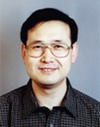
He-qing Huang,Dr. Prof.
Institute of Geographic Sciences and Natural Resources Research
Email:huanghq@igsnrr.ac.cn
Tel:010-64888992
Mobile:13141362538
Post address:11A Datun Road, Chaoyang District, Beijing, China
Post Code:100101
Research Areas
Fluvial Processes and Landforms
Geomorphology
River Basin Management
Education
1979-1983, Undergraduate student, Wuhan University of Hydraulic and Electrical Enginnering (now Wuhan University), Wuhan, Hubei Province,
1983-1986, Postgraduate student for Master degree, Department of Hydraulic Engineering, Tsinghua University, Beijing,
1993-1996, Ph.D student, Department of Geography, University of Wollongong, NSW,
Work Experience
1986-1991: Commission for Integrated Research of Natural Resources, Chinese Academy of Sciences, Beijing,
1991-1992: Visiting scholar, University of Newcastle, New South Wales, 2308,
1992-1993: Visiting scholar and research assistant, Department of Geography, University of Sydney, New South Wales, 2001,
1997-1999: Postdoctoral Researcher, University of Wollongong, New South Wales, 2522,
1999-2002: Research Fellow, Department of Geography and Geomatics, University of Glasgow, G12 8QQ,
2002-2005: Research Fellow, School of Geography and the Environment, University of Oxford, OX1 3TB,
Oct 2005-: Professor of Physical Geography, Institute of Geographic Sciences and Natural Resources Research,
Chinese Academy of Sciences, 11A Datun Road, Chaoyang District, Beijing, 100101,
Publications
Published more than 100 research papers in journals,with the following papers as representatives:
1. Liu, X., Huang, H.Q., and Nanson, G.C. (2016). The morphometric variation of islands in the middle and lower Yangtze River: a variational analytical explanation. Geomorphology, 261, 273-281.
2. Ma, Y., and Huang, H.Q. (2016). Controls of channel morphology and sediment concentration on flow resistance in a large sand-bed river: a case study of the lower yellow river. Geomorphology, 264, 132-146.
3. Zhou, Y., Huang, H.Q., Nanson, G.C., Huang, C., and Liu, G. (2015). Progradation of the Yellow (Huanghe) River delta in response to the implementation of a basin-scale water regulation program. Geomorphology, 243, 65–74.
4. He Qing Huang, Caiyun Deng, Gerald C. Nanson, Beilin Fan, Xiaofang Liu, Tonghuan Liu and Yuanxu Ma (2014). A test of equilibrium theory and a demonstration of its practical application for predicting the morphodynamics of the Yangtze River. Earth Surface Processes and Landforms, 39, 669–675.
5. He Qing Huang, Xiaofang Liu, Gerald C. Nanson (2014). Commentary on a Conceptual model for complex river responses usingan expanded Lane diagram by David Dust and Ellen Wohl”, Geomorphology, Volume 139–140, March 2012, Pages 109–121. Geomorphology 209, 140–142.
6. Guo-an Yu, He Qing Huang, Zhaoyin Wang, Gary Brierley, Kang Zhang (2012). Rehabilitation of a debris-flow prone mountain stream in southwestern China – Strategies, effects and implications. Journal of Hydrology, 414–415, 231–243.
7. Yuanxu Ma, He Qing Huang, Gerald C. Nanson, Yong Li, Wenyi Yao (2012). Channel adjustments in response to the operation of large dams: The upper reach of the lower Yellow River. Geomorphology, 147–148, 35–48.
8. Gary Brierley, He Qing Huang, Anze Chen, Simon Aiken, Mike Crozier, Wolfgang Eder, Andrew Goudie, Yuanxu Ma,Jan-Hendrik May, Piotr Migon, Gerald Nanson, Deli Qi, Heather Viles, Chris Wood, Robert Wray, Guifang Yang, Xiaoping Yang and Guo-an Yu (2011). Naming conventions in geomorphology: contributions and controversies in the sandstone landscape of Zhangjiajie Geopark, China. Earth Surface Processes and Landforms, 36, 1981–1984.
9. Huang, He Qing (2010). Reformulation of the bed load equation of Meyer‐Peter and Muller in light of the linearity theory for alluvial channel flow, Water Resources Research, 46, W09533, 1-9.
10. Yuanxu Ma, He Qing Huang, Jiongxin Xu, Gary J. Brierley, Zhijun Yao (2010). Variability of effective discharge for suspended sediment transport in a large semi-arid river basin, Journal of Hydrology, 388, 357-369.
11. Nanson, G.C. and Huang, H.Q. (2008). Least action principle, equilibrium states, iterative adjustment and the stability of river channels, Earth Surface Processes and Landforms, 33, 923-942.
12. Huang, H.Q. and Nanson, G.C. (2007). Why some alluvial rivers develop an anabranching pattern, Water Resources Research, 43, W07441, 1-12.
13. Huang, H.Q. and Chang, H.H. (2006). Scale independent linear behavior of alluvial channel flow, Journal of Hydraulic Engineering, American Society of Civil Engineers, 132(7), 721-730.
14. Huang, H.Q., Chang, H.H. and Nanson, G.C. (2004). Minimum energy as a general form of critical flow and maximum flow efficiency and for explaining variations in river channel pattern, Water Resources Research, 40, W04502, 1-13.
15. Huang, H.Q. and Nanson, G.C. (2002). A stability criterion inherent in laws governing alluvial channel flow, Earth Surface Processes and Landforms, 27(8), 929-944.
16. Huang, H.Q., Nanson, G.C. and Fagan, S.D. (2002). Hydraulic geometry of straight alluvial channels and the variational principle of least action, Journal of Hydraulic Research, 40(2), 153-160.
17. Huang, H.Q. and Nanson, G.C. (2000). Hydraulic geometry and maximum flow efficiency as products of the principle of least action, Earth Surface Processes and Landforms, 25, 1-16.
18. Huang, H.Q. and Nanson, G.C. (1998). The influence of bank strength on channel geometry, Earth Surface Processes and Landforms, 23, 865-876.
19. Huang, H.Q. and Nanson, G.C. (1997). Vegetation and channel variation; a case study of four small streams in southeastern Australia, Geomorphology, 18, 237-249.
20. Huang, H.Q. and Warner, R.F. (1995). The multivariate controls of hydraulic geometry; a causal investigation in terms of boundary shear distribution, Earth Surfaces Processes and Landforms, 20, 115-130.
